전 국민 QA가 던진 학습 과제 TL;DR 이번 개편은 일반 사용자 vs. IT 메이커의 서로 다른 관점이 크게 충돌한 사건이다. 두 관점은 함께 고려되어야 한다. 대중은 "불편하면 안 쓴다/편하면 쓴다"로 판단하지만, 업계는 왜 이런 결정이 났는지와 무엇을 배울지를 끝까지 추적해야 한다. 토스 출신이 어쩌고, 광고 매체가 어쩌고는 이러한 문제의 시작점이라기 보단 재료들에 가깝다. 이 사건은 사실상 전 국민을 대상으로 한 초대형 유저 테스트였고, 여기서 얻은 데이터와 경험은 다음 제품 의사결정의 핵심 인사이트가 된다. 당신이 iT 업계 사람이 아니라면 사실 그냥 뉴스 정도로 넘어갈 수 있지만 만약 IT 업계 종사자면 한 번 생각해보자. https://youtu.be/KSR3h8Pd5-I?si=rhMgDNesm1oY0FwF 최근 카카오톡의 대규모 개편은 다양한 논쟁을 불러일으키고 있습니다. 저는 이번 개편을 '전 국민 QA(품질 검사)'라고 정의하며, IT 업계 종사자들에게는 많은 배울 점이 있는 중요한 사건으로 보고 있습니다. 일반 사용자들의 불만 표출을 넘어, 이번 개편이 한국 사회와 IT 업계에 미치는 영향에 대한 심층적인 분석이 필요하다고 강조합니다. 카카오톡이 스스로를 '국민 메신저'로 칭하며 대대적인 변화를 시도한 것은, 서비스가 이미 우리 일상생활의 인프라와 같은 위치에 있기 때문입니다. 사용자들이 다른 대안으로 쉽게 갈아탈 수 없는 상황을 카카오 역시 인지하고 있으며, 이것이 사용자들이 불만을 표하면서도 서비스를 계속 이용할 수밖에 없는 딜레마를 초래했다고 설명합니다. 숏폼 도입의 문제점: 사용자 경험과 플랫폼 본질 이번 개편에서 특히 논란이 된 것은 '숏폼' 기능 도입입니다. 저는 숏폼이 고객이 원하지 않는 경험을 강요한다고 지적합니다. 유튜브나 인스타그램, 틱톡처럼 콘텐츠 소비를 목적으로 하는 플랫폼과 달리, 카카오톡 오픈 채팅방은 정보 교환과 소통이 주 목적인 공간인데, 여기에 쇼폼을 자동 재생으로 배치한 것이 문제라는 것입니다. 쇼폼 도입의 더 큰 문제는 일부 인플루언서에게만 콘텐츠 업로드 권한을 부여했다는 점입니다. 이는 과거 네이버 '미투데이'가 연예인 계정에 특혜를 주어 실패했던 사례와 유사하다고 비판합니다. SNS의 본질은 '연결'과 모두에게 노출될 기회를 제공하는 것인데, 카카오톡은 이를 망각하고 소수에게만 기회를 주는 '폭력적인' 방식을 택했다고 강조합니다. 광고 수익 모델과 경제 상황의 이해 광고 증가에 대한 비판에 대해 화자는 대부분의 플랫폼 회사가 기본적으로 광고 비즈니스를 통해 수익을 창출한다는 점을 강조합니다. 광고 지면 확보는 당연한 전략이지만, 중요한 것은 시장 상황입니다. 경기가 어려울수록 마케팅 비용이 축소되기 때문에, 단순히 광고 지면을 늘린다고 해서 매출이 폭발적으로 증가하지는 않을 것이라고 분석합니다. 또한, 유튜브 프리미엄처럼 광고를 보지 않기 위해 돈을 지불하는 모델을 언급하며, 사용자들이 기꺼이 비용을 지불할 만큼의 가치를 카카오톡이 제공하고 있는가에 대한 질문을 던집니다. 과거 카카오TV, 카카오뮤직 등 다양한 콘텐츠 시도가 실패했던 사례를 볼 때, 광고 외에 새로운 가치 제공이 절실하다고 말합니다. 카카오의 위기감과 의사결정의 문제 카카오가 이번 개편을 단행한 배경에는 기술적인 변화와 시대의 흐름에 대한 위기감이 있었다고 분석합니다. ChatGPT 등 AI 기술이 급부상하는 상황에서 카카오가 사용자들에게 '기술 회사'로서의 새로운 가치를 보여주지 못하고 있다는 인식이 작용했을 것이라는 설명입니다. 이러한 위기감이 '구국의 결단'처럼 변화를 추진하는 기폭제가 되었을 것이라고 추정합니다. 화자는 이번 개편의 캐치프레이즈가 '사용자 맞춤형'이었음에도 불구하고, 실제로는 쇼폼 등으로 인해 본래 의도가 제대로 전달되지 않았다고 평가합니다. 폴더 관리, PC 카톡 오픈 채팅 분할 등 일부 유용한 기능들이 추가되었지만, 쇼폼의 부정적 경험에 가려져 주목받지 못하고 있다는 것입니다. 블라인드 비판의 허와 실: 개인 비난의 위험성 블라인드에서 토스 출신 CPO와 팀에 대한 비판이 쏟아지는 것에 대해 화자는 우려를 표합니다. 어떤 프로덕트도 한두 명의 개인의 의사결정만으로 배포되지 않으며, 수많은 과정과 팀의 노력이 수반된다는 점을 강조합니다. 또한, '카무원'이라는 용어가 토스 출신들이 만든 신조어가 아니라, 이미 오래전부터 대기업에서 자조적으로 사용되던 표현이었다는 점을 지적합니다. 특정 개인을 '악마화'하고 조리돌림하는 문화는 게임 업계에서 온 폭력적인 문화와 유사하다고 비판합니다. 게임 디렉터에 대한 풍자는 게임 내에서 '왕'과 같은 절대적인 권력을 가진 강자를 향한 것이었지만, 지금의 CPO 비난은 단순한 풍자를 넘어 개인에 대한 부당한 사냥에 가깝다는 것입니다. 이러한 개인 비난은 건설적인 논의를 방해하고 발전을 저해한다고 주장합니다. 더불어 블라인드 글 작성자가 실제 IT 프로덕트 전문가인지 확인하기 어렵다는 점을 들어, 내부자 발언이라고 해서 무조건 진실로 받아들이는 태도를 경계해야 한다고 말합니다. 광고 노출 증가가 무조건 매출 증대로 이어지지 않듯, 사용자의 불만이 즉시 롤백으로 이어질 수 없는 복잡한 개발 로드맵이 존재함을 이해해야 한다고 덧붙입니다. 변화에 대한 소통 부재와 미래 지향점 저는 이번 카카오톡 개편의 가장 큰 문제점 중 하나로 변화에 대한 사용자 소통의 부재를 꼽습니다. 인스타그램, 틱톡, 왓츠앱 등 글로벌 서비스들은 업데이트의 맥락과 이유를 상세하게 설명하고, 출시 로드맵을 미리 공개하며 사용자를 설득하는 과정을 거친다는 것입니다. 반면 카카오톡은 "지금 바뀌었다"는 식으로 일방적인 업데이트를 강행하여 사용자들의 당혹감과 반발을 불러일으켰다고 지적합니다. 과거 네이버 역시 대대적인 개편 시 사용자들의 큰 반발에 부딪혔지만, 결국에는 변화를 수용하고 정착시킨 사례를 언급하며, 변화에는 항상 불편함이 동반된다는 점을 강조합니다. 다만 카카오의 이번 개편 방식이 너무 폭력적이고 핵심 기능을 훼손했다는 점은 명확한 실수라고 인정합니다. 화자는 카카오가 이번 사태를 통해 사용자 중심의 로드맵 공개와 단계적 업데이트 방식을 배워야 한다고 제언합니다. 게임 업계처럼 민감한 사용자 피드백을 반영하고, 미리 테스트하며 변화의 맥락을 설명하는 노력이 필요하다는 것입니다. 과거 카카오가 약속을 지키지 못했던 경험 때문에 소통을 주저했을 수 있지만, 이는 결국 더 큰 반발을 초래하는 결과를 낳았다고 분석합니다. 결론적으로 이번 카카오톡 대개편은 카카오 내부뿐만 아니라 IT 업계 전반에 타산지석이 될 수 있는 중요한 기회라고 평가합니다. 단순히 비난에 그치지 않고, 왜 이런 결과가 발생했는지 성찰하고 건설적인 방향으로 나아가야 한다고 촉구하며, 남을 비판하는 것은 쉽지만 실제 문제를 해결하는 것은 훨씬 어렵다는 점을 강조합니다.




























